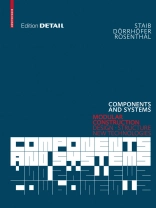Construction systems reduced to the smallest possible number of identical elements have long been used by architects to build structures as well as dismantle and change them as quickly, efficiently, and economically as possible. Think of the architecture of the nomads, the Crystal Palace designed by the architect John Paxton for the London World’s Fair of 1851, or the modern construction systems of the nineteenth and twentieth centuries in steel, concrete, and wood.
Coupled with modern digital planning and production methods, modular precast construction systems that are adaptable for many combinations and capable of being combined with one other will play an increasingly important role in architecture in the future.
The volume Components and Systems offers an in-depth and clearly organized presentation of the various types of precast building components – from semifinished products to building with components, open and closed systems, and skeleton and panel construction all the way to spatial cell constructions. The systems are accompanied by detailed drawings and color photographs.
Discussions of transporting and assembling the various systems round off the topic and make this book an indispensable practical companion.
Seit jeher werden in der Architektur auf möglichst wenige, gleiche Elemente reduzierte Bausysteme verwendet, um möglichst schnell, effizient und ökonomisch ein Bauwerk errichten oder auch abbauen und verändern zu können. Man denke an die Architektur der Nomaden, den Kristallpalast, der 1851 anlässlich der in London stattfindenden Weltausstellung von dem Architekten John Paxton entworfen wurde, oder die modernen Bausysteme des 19. und 20. Jahrhunderts in Stahl, Beton oder Holz.
Elementierte, vorgefertigte, für viele Kombinationen anpassungsfähige und untereinander kombinierbare Systeme werden zukünftig, gekoppelt mit modernen digitalen Planungs- und Produktionsmethoden, einen immer wichtigeren Aspekt in der Architektur darstellen.
Der neue Band Elemente und Systeme zeigt fundiert und übersichtlich die verschiedenen Arten vorgefertigter Bauteile auf – von Halbfabrikaten über das Bauen mit Komponenten, offenen und geschlossenen Systemen, Skelett- und Paneelbauweisen bis zu Raumzellenkonstruktionen. Ergänzt werden die Systeme durch detaillierte Zeichnungen und Farbfotos. Transport und Montage der verschiedenen Systeme runden das Thema ab und machen dieses Buch in der Praxis unverzichtbar.
Mục lục
1. Introduction – characteristics of component-based construction and object-oriented modular construction (CAM).- 2. Types of construction – semifinished products, components, open and closed systems.- 3. Principles of modularization (skeleton construction, panel construction, panel systems) for the various building materials.- 4. Assembly systems.- 5. Preview of new technologies.
Giới thiệu về tác giả
Gerald Staib ist Professor für Baukonstruktion und Entwerfen an der TU Dresden












